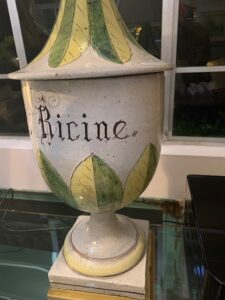 PO sent me a photo of a Portuguese majolica covered earthenware glazed pot, large at twenty inches tall. I see the word “Rincine” on the cover in Latin. The colors are yellow and green on a background of white colored glazes. I put it in the early 19th century. This is an apothecary’s vessel from the Iberian peninsula. They called this type of earthenware faience, meaning hard baked terracotta with a dense glaze. Regionally in Spain and Portugal they often call this majolica.
PO sent me a photo of a Portuguese majolica covered earthenware glazed pot, large at twenty inches tall. I see the word “Rincine” on the cover in Latin. The colors are yellow and green on a background of white colored glazes. I put it in the early 19th century. This is an apothecary’s vessel from the Iberian peninsula. They called this type of earthenware faience, meaning hard baked terracotta with a dense glaze. Regionally in Spain and Portugal they often call this majolica.
So perfect for apothecary usage because once the glaze sets the vessel becomes impervious to moisture and staining.
I’m always surprised by the size of these vessels, because they contained lethal drugs in many cases. The theory of homeopathy claims that a small dose of something lethal often triggers the body to react favorably. This theory became significant in the old apothecary shops, but they also employed the opposite, that high dosages of poisons were necessary as well. Oh, BOY!
In the 16th and 17th centuries, at the ‘chemist,’ one saw these vessels lining the shelves. They contained any manner of plant-based materials.
Majolica Vessel Looks 16th Century
This vessel is probably the most interesting one of its type I’ve seen in years. It seems to date from the early 19th century and is majolica, suggesting it hails from Spain or Portugal. The design is more modern, so it could be a reproduction vessel from the early 20th century. In any event it looks like a 16th century vessel.
The plant-based material it once contained was Ricin, a lectin, a potent toxin produced in the seeds of the castor oil plant, called by its Latin name Ricinus Communis.
How lethal?
The power of this is toxic if inhaled, or injected, or ingested, is deadly, because it inhibits the body’s protein synthesis. Meaning the little powder once housed in this vessel caused a fatal hemorrhage in the mucous membranes of the gastrointestinal system.
Sometimes we don’t understand how much people knew about plant medicine well before us. They also knew about what poisons did. So, this vessel from the early 19th century reminds us how much our ancient understanding of toxins influenced early medicine. This vessel with its Latin nomenclature, harkens back to the 15th and 16th century.
In WWI and WWII the biological properties of ricin were examined closely as a weapon. Breaking Bad fans saw the Ricin toxin discussed as a real weapon, and a real problem.
Remarkable Majolica
The vessel itself is remarkable for its shape and glaze in the style called faience, meaning earthenware, sealed by a heavy and pigmented glaze. This style was used for any and all vessels for the table, and for the chemist’s shop, when one needed a watertight vessel. Porcelain, prohibitively expensive at that time, didn’t become available in Europe until the 19th century. Kilns used to make porcelain, once discovered in Europe, were expensive. Porcelain is fired to 2,000 degrees, faience at a far lower temperature, and is as watertight with a cheap salt base or lead based glaze. So faience, or majolica, served as tableware, or any other non-porous vessel, for hundreds of years.
I find it interesting that PO collectors objects known to the ancient apothecary shops. I had the honor of closing a great Santa Barbara chemist’s shop, and helped sell their collected antiques. We donated many objects to the Alexandria, Virginia based museum, The Stabler-Leadbeater Apothecary Museum. You will find that this museum boasts a vast collection of herbal botanicals, hand-blown glass, and medical equipment. It also has a spectacular collection of archival materials, including journals, prescription and formula books, ledgers, orders, and invoices. The museum is a National Historic Landmark.
If they knew about PO’s Ricine vessel they’d DROOL. I have no real idea of the value as I don’t know apothecary material but I suggest $1,000 and above.